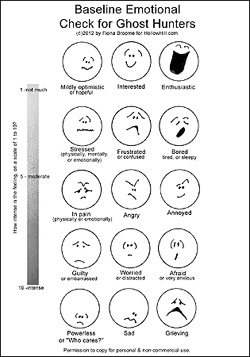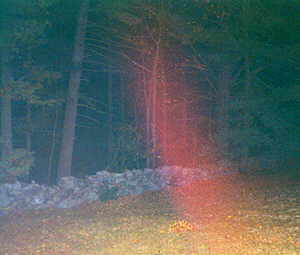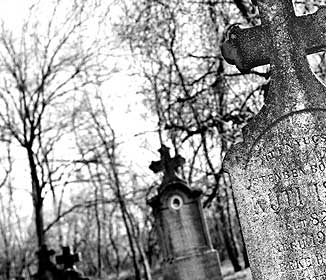As an Amazon Associate I earn from qualifying purchases. Click for details.
This is the fourth lesson in Hallowfields’ free Ghost Hunting for Beginners course.

It’s time to prepare for a serious ghost hunt, and then going on multiple investigations.
 This lesson may be challenging, and it’s likely to take you several weeks (or longer) to complete.
This lesson may be challenging, and it’s likely to take you several weeks (or longer) to complete.
Have patience. Mastering this lesson – taking your time to become comfortable with each facet of ghost hunting – will make a big difference in your success in the future.
Don’t rush anything.
Start with simple sites, even predictable ones.
Then, as your confidence builds, try different kinds of haunts, and those with reports of more vivid activity.
Choose a convenient, perhaps familiar site
To start of this lesson, I recommend revisiting one of the sites you explored during the previous lesson, Your First Ghost Hunt.
During your investigations, be sure to remember the 3 Easy Mistakes Beginners Can Make.
Let’s start by listing the basics. You’re probably familiar with some of these points.
That’s good. During real, thorough, professional ghost investigations, some of these steps become very important.
Here are the basic steps of an investigation
The following are the steps I recommend for any thorough investigation. We’ve already discussed several of them.
In this lesson, I’ll cover a few points in detail.
Some require more explanation than I can cover in a simple article. I’ll provide resources for them, later.
Others are logical steps you’ve seen on most ghost hunting TV shows.
Here’s the usual sequence. Modify it to suit your goals, limits, resources, interests, and available research sites.
- Select your companions or team. (This was covered, briefly, in the second lesson: Your First Ghost Hunt.) Never go ghost hunting by yourself. Ever.
- Choose a location and investigation time. Double-check the address and when the site is open, etc. (I’m especially enthusiastic about haunted graveyards and cemeteries, due to convenience, safety, and how haunted many are.)
- Visit the location during the daytime, or arrive before dusk to get a sense of what’s where, and any dangers at the site.
- Baseline yourself so you know when an entity is affecting you.
- Select the tools (if any) best suited to the site, the weather, the ghost stories, and so on. Remember to have extra batteries for electronic tools. (Frankly, I don’t recommend using ghost hunting equipment. Not at first. But, if you do, put the equipment down after the first 20 minutes or so. Be “in the moment” and experience the historical and ghostly energy at the site.)
- When everyone is ready for the investigation, pause for spiritual protection, if appropriate.
- Then, walk through the site as a group, noting anything important. That includes hazards, things that other teams have mentioned, local folklore, and anything that seems to get your attention (even if you’re not sure why).
- If you’ll be using digital equipment, run baseline checks, especially of EMF.
- Then, organize into teams of two or three, and investigate. Go slowly! Document what you find. Note time, place (GPS?), weather, emotional impact, and anything odd, even if it doesn’t seem ghostly at the time.
- Unless anomalies are happening at a steady pace, debunk as much as you can as you go along. Note your debunking efforts, too, so you don’t forget. (If you’re working in teams of three, two can debunk while the third keeps watch for anything new and anomalous. Or vice versa.)
- Leave if anything frightens you, or if you’re asked to leave by owners or police.
- Continue research until it’s time to leave. That could be when everyone is tired, when all “hot” areas have been investigated, or at a specific time you’d already agreed upon.
- Pause to thank the spirits, wish them comfort (or whatever seems appropriate), and renew your spiritual protection, as needed.
- Optional: Meet at a designated coffee shop or other location, to discuss what just happened (and what didn’t). You may start reviewing evidence then, exchange digital files, possible ghost photos, etc.
- Review your notes and evidence, on your own, and then with the group.
- Revisit the site – possibly during the daytime and after dark – to debunk evidence that needs a second look.
- Plan your next investigation.
With those routine steps in mind, let’s talk about a few details, starting with a baseline.
Baseline yourself
 During every investigation, it’s essential to separate how you feel from how the ghosts affect you.
During every investigation, it’s essential to separate how you feel from how the ghosts affect you.
Often, the first evidence of a haunting is subtle. It’s that little – perhaps illogical – shift in your emotions. Or a slight discomfort in your upper back. And so on.
After that, the evidence grows until you can’t ignore it. If you waited too long to recognize what’s going on, you could be at risk.
It’s best to be on your guard from the very start.
So, before every investigation, pause and consider how you feel at that moment.
- How was your day, so far?
- How’s your health (and allergies)?
- Have you eaten recently?
- Any chance that you’re a little dehydrated?
- Did you dress appropriately for the weather and the location? Can you tell a paranormal chill from a normal breeze? Is your footwear suited to where you’ll be walking?
Always know how you feel upon arrival. That’s the best way to tell if – at the haunted site – a ghost is having an effect on you, physically or emotionally.
This kind of check becomes easy, even second nature, after a few dozen ghost hunts. But, at first, you may need to pause and assess how you feel and how well prepared you are for the investigation.
See my article, Baseline Yourself, for more information, links to free worksheets, and a helpful podcast.
Tools for Beginning Ghost Hunters
It’s not necessary to use any tools during a ghost hunt. If you’re a spiritual or religious person, I recommended carrying some symbol of spiritual protection, but even that is optional.
Also, many people like to shield themselves spiritually, before entering the haunted site.
- You may say a prayer.
- You might mentally ask a relative – someone who’s already crossed over – to be with you and protect you.
- You might carry a quartz crystal, a religious medal, or rosary beads.
- You could imagine yourself protected by a pink bubble of loving energy.
- Or, you may prefer to think of yourself shielded by a vivid blue light shining down from the heavens above.
As a beginner, I recommend a simple prayer or comforting ritual – even something like stargazing while sipping cocoa – before beginning a ghost investigation.
At the very least, that kind of routine can clear your mind of lingering thoughts from earlier in the day. You’ll feel fresher and more focused as you start the investigation.
Whatever you use, make sure it aligns with your spirituality. If some of your companions want to use a circle to ask for protection, but – as a Christian – that troubles you, don’t join them. Instead, take a few minutes for personal prayer.
And vice versa: if your friends want to pray to Deity, out loud, but their references to Jesus Christ or God (in their religious context) make you uneasy, it’s okay to step to one side and use a silent meditation.
Whatever you decide, it’s important to use your preferred means of spiritual protection. Do not compromise on this. That’s important.
Not worried?
If spiritual protections seems silly, I still hope you’ll approach your first investigation with caution.
And I hope you never encounter anything truly terrifying or dangerous. Odds are, you will be frightened by something, at some point. But when that happens, I hope you’re prepared and remain safe.
- Some sites are safer than others, in terms of physical issues like weak floorboards, spiders, bats, and rodents, and so on. Avoid bursting into a room, or running up a staircase that hasn’t been used in years. Attics, barns, and basements are especially risky, especially in terms of respiratory dangers.
- Some sites do present spiritual dangers. You’re unlikely to stumble onto one of those during early investigations. Research each site, online, if you’re not sure.
- At any point you feel frightened, leave the site immediately. Your internal warning system can be your best defense during investigations that become risky.
When I watch some ghost hunting teams on TV, I look at the risks they’re taking. I hope the worst dangers were staged (or at least exaggerated) during filming.
But when I see someone talking about demons, and staying at the site anyway, I shake my head. Either those researchers are remarkably stupid or foolhardy, or both.
I hope they never reap the consequences of their mistakes. And, if/when they do, I hope they recover fully and quickly.
Do not emulate what you see on TV. What they claim they’re doing…? It might be something staged, or stupidly suggested by a producers.
Above all, don’t go looking for “a good scare.” You risk getting more than you expected, and putting yourself – and your companions – in danger.
The most important tools are your five or six senses.
Yes, I keep talking about your five senses… or six if you believe in that and feel gifted. (You don’t have to, to be a successful ghost hunter.)
During your first several investigations, just observe.
Listen for strange noises and odd silences.
Watch for strange lights, shadows or figures. Pay special attention to dark corners and reflective surfaces.
Mirrors, windowpanes, and shiny surfaces can reflect ghostly images. See this video:
All of your senses should be on alert. Some people hear ghosts. Some people see them. Many people report things like an odd chill, or breath on their faces, necks, or arms.
Other people sense changes in movement or energy.
Here’s an example.
An energy field at Gilson Road Cemetery

At New Hampshire’s Gilson Road Cemetery, we discovered an unusual energy field. At the time, we said it felt like “wading through molasses.”
In later investigations, we felt it again. It was never as strong as that first time, but it’s something we’ve never forgotten.
The first time, it was a little alarming. I worried that, at some point, someone might be paralyzed by the energy field.
Fortunately, we kept wading. The energy field was about 20 or 30 feet across, and denser at the middle. When we escaped it, we felt a little drained, but that’s all.
To this day, I have no idea what it was. Maybe it was residual energy from violent deaths at that location, centuries ago.
Or perhaps it was connected with the unmarked graves and misplaced headstones at that cemetery. (You can read more about haunted Gilson Road Cemetery in New Hampshire, USA, at HollowHill.com.)
During your investigations, notice what’s going on internally. Are you feeling excited, or a little drained of energy, or both? Are your emotions significantly different from earlier in the day? (This is when your baseline checks are important.)
Those observations are at the core of ghost hunting.
Normal, expected risks
Some haunted sites present physical risks. Abandoned or neglected buildings can have rotted floors, uneven stairs, dangerous mold and mildew, or even a rodent population.
(The latter – and hantavirus – is why many of us wear masks at messy haunted sites. An N95 or a mask that filters nano particles is recommended, but – as of 2020 and Covid-19 – most of us own those kinds of masks, now.)
 Outdoors – especially in the dark -at poorly maintained battlefields and cemeteries, you may stumble onto unmarked graves (depressions the size and shape of buried coffins), exposed tree roots, and holes dug by rodents and snakes.
Outdoors – especially in the dark -at poorly maintained battlefields and cemeteries, you may stumble onto unmarked graves (depressions the size and shape of buried coffins), exposed tree roots, and holes dug by rodents and snakes.
In wooded areas frequented by hunters (whether or not it’s hunting season), wear something reflective or brightly colored.
(Neon-colored vests are inexpensive. You can buy them at stores such as Target, sporting goods stores, and online retailers like Amazon.)
Never rely on your mobile phone for safety. In many haunted places, EMF levels can be high. Electrical devices – including phones, cameras, and other devices – can fail. Usually, the problem is the battery. Even freshly charged devices can go flat as soon as you enter haunted location.
Watch this if stairs are involved…
The battery issue
Some say ghosts drain battery energy for their own use. I’m not ready to believe that. But, I’ve seen all electrics lose power – almost instantly – upon arriving at investigation sites.
Here’s a short video about what to do if you’re using a phone (or other electronics) for ghost hunting, and the batteries go flat.
(URL: https://youtu.be/MBTulC6Gbqw)
Of course, you could just leave the site if you’re uneasy about how (and why) ghosts might be tampering with your camera, phone, or other gadgets.
Mostly, never assume that it’s okay to go alone to a deserted, haunted place. If you need to call for help, your phone may not work.
(The good news is: electronic equipment often starts working again – as if nothing had happened – when you leave the haunted site. I’ve seen flat batteries seem to recharge themselves, about 1/4 mile from our investigation.)
Continue until you’re comfortable, or at least more confident
I recommend repeated investigations at that location, until you start to feel comfortable with the process.
Then, use the resources mentioned in “Choose a place to investigate” (in the lesson, Your First Ghost Hunt) to find additional sites to investigate.
If you’re running out of haunts to explore, you can Use History to Find Haunted Places. That’s one of my favorite ways to discover ghostly sites that haven’t been over-investigated.
No two sites – and usually no two investigations – will be the same.
Also, no matter how many years you’re in this field, you’ll still encounter phenomena you didn’t expect.
Sometimes, you’ll be unprepared for it.
Never think you’ve seen, heard, or experienced everything ghosts and other entities can throw at you.
If you become complacent, you’re at risk.
When you’re ready for your next lesson…
Next, let’s discuss a topic that many ghost hunters shrug off… until something terrible happens.
Even if you’re still getting used to ghost hunting, the following lesson may be important.
I truly hope nothing bad or truly scary ever happens to you during or immediately after a ghost hunt.
Mostly, I want you to be thoroughly prepared, just in case.
With that in mind, it’s time to learn about the biggest Ghost Hunting Dangers. That’s next in this course.
